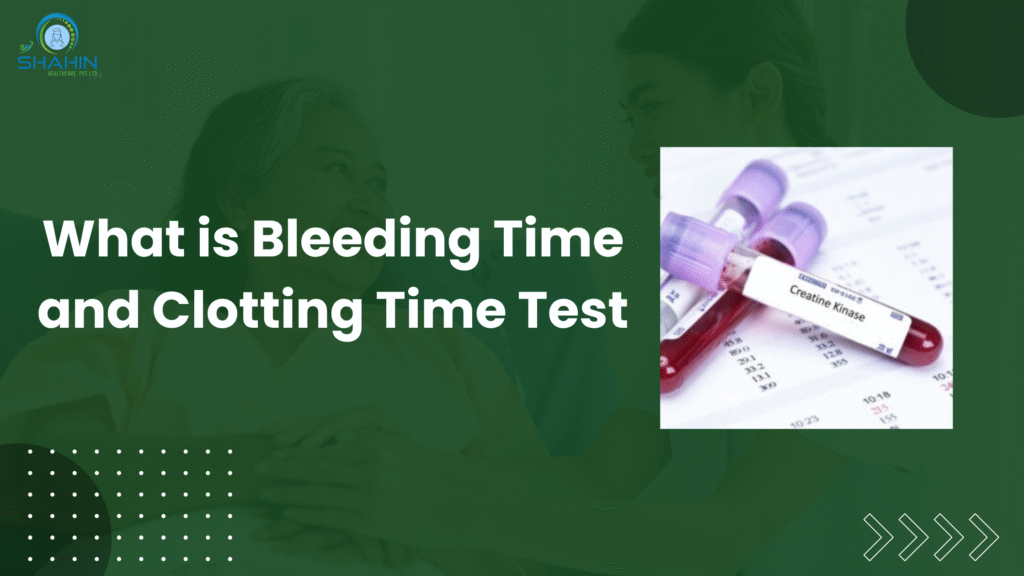When it comes to maintaining good health, understanding how your body controls bleeding is vital. Two critical medical tests, Bleeding Time (BT) and Clotting Time (CT), play a foundational role in diagnosing several blood-related disorders. Collectively, these are referred to as the BT CT Test, and they help both doctors and patients assess how efficiently the body can stop bleeding and form clots. In this expansive guide, you will learn everything you need to know about bleeding time and clotting time, including the normal bleeding time and clotting time, BT CT full form, normal BT CT time, BT CT test procedures, their significance, interpretation, and commonly asked questions.
What Are Bleeding Time and Clotting Time Tests?
Before we dive into the details, let’s define what each term means:
-
Bleeding Time (BT): This test measures how long it takes for bleeding to stop after making a minor cut or puncture in the skin. This duration largely depends on how well your platelets are functioning and the health of your blood vessels.
-
Clotting Time (CT): This test measures how long it takes for blood to clot in a test tube, reflecting the efficiency of your blood’s clotting factors.
Together, the BT CT test provides a comprehensive assessment of the two main components of hemostasis: the formation of a platelet plug and the subsequent development of a stable fibrin clot. These simple but effective tests offer crucial insights into your blood’s ability to prevent excessive bleeding.
BT CT Full Form
Understanding the terminology is essential for patients, students, and healthcare professionals:
-
BT = Bleeding Time
-
CT = Clotting Time
So, whenever you encounter BT CT test, remember it stands for Bleeding Time and Clotting Time Test.
Why Are Bleeding Time and Clotting Time Tests Important?
The importance of knowing your normal bleeding time and clotting time cannot be overstated, especially under certain circumstances:
-
Presurgical Assessment: The BT CT test is frequently ordered before surgeries and invasive procedures to evaluate bleeding risk. Unexpected bleeding during surgery can cause complications, so identifying risks early is vital.
-
Investigation of Bleeding Disorders: If a patient reports frequent nosebleeds, heavy menstrual periods, unusual bruising, or excessive bleeding after dental extractions or minor injuries, the bleeding time and clotting time test helps pinpoint the problem.
-
Monitoring Medications: Patients taking medicines like anticoagulants (blood thinners) or antiplatelet drugs (like aspirin) may need regular BT CT tests to ensure their blood does not become too thin, leading to dangerous bleeding.
-
Diagnosis and Management: These tests assist in diagnosing disorders such as hemophilia, von Willebrand disease, thrombocytopenia, and various other platelet or clotting factor abnormalities.
What Is the Normal Bleeding Time and Clotting Time?
To interpret any laboratory test, understanding the normal BT CT time is critical. This baseline helps distinguish between normal and abnormal values, guiding diagnosis and treatment.
Normal Bleeding Time and Clotting Time
-
Bleeding Time (BT): 2 to 7 minutes
-
Clotting Time (CT): 8 to 15 minutes
Note: These ranges may vary slightly depending on the laboratory method, the patient’s age, and health status, but the above values are widely accepted as standard.
Why Are These Ranges Important?
These values indicate efficient platelet function, healthy blood vessels, and a robust coagulation cascade. Abnormalities in either reading may prompt further investigation to prevent serious health issues.
How Is the BT CT Test Performed?
Bleeding Time Test Procedure
-
Preparation: The area (usually the forearm) is sterilized.
-
Incision: A small, shallow cut or puncture is made using a standardized lancet.
-
Monitoring: A blood pressure cuff may be applied to the upper arm to maintain steady pressure. The blood is blotted gently every 30 seconds with filter paper until bleeding stops. The time taken is noted as the bleeding time.
-
Methods Used: The most commonly used methods are the Ivy method (incision on the forearm under pressure) and the Duke method (prick on the earlobe or fingertip).
What Does Bleeding Time Measure?
The BT portion of the BT CT test measures the interaction between platelets and blood vessel walls—a crucial first step in stopping blood loss after injury.
Clotting Time Test Procedure
-
Sample Collection: Blood is drawn from a vein or obtained via a finger prick and placed in a clean, dry test tube or capillary tube.
-
Observation: Every 30 seconds, a small segment of the tube is broken to visually check for clot formation. The interval from collection to visible clot formation is recorded.
-
Result: The measured interval is the clotting time.
What Does Clotting Time Measure?
The CT portion examines how quickly the various plasma coagulation factors can work together to form a stable clot—critical for preventing excessive blood loss.
How Do You Prepare for a BT CT Test?
Preparing for the bleeding time and clotting time test is simple:
-
Usually, no fasting is necessary.
-
Inform your doctor about all medications and supplements you’re taking, as some (like aspirin or NSAIDs) can affect results.
-
Your doctor may advise you to temporarily stop taking blood thinners before the test.
-
No other specific preparation is generally needed.
Interpreting BT CT Test Results
What If Your Bleeding Time or Clotting Time Is Abnormal?
1. Prolonged Bleeding Time (BT):
-
Possible Causes: Platelet disorders (like ITP, thrombocytopenia), congenital platelet dysfunction, von Willebrand disease, medications (especially aspirin and NSAIDs), vitamin C deficiency, uremia, and vascular issues.
-
What It Indicates: Difficulty in forming the initial platelet plug, increasing the risk of minor or moderate bleeding.
2. Prolonged Clotting Time (CT):
-
Possible Causes: Deficiency of clotting factors (as seen in hemophilia A or B), liver disease (which affects the production of clotting factors), vitamin K deficiency, blood-thinning drugs, or disseminated intravascular coagulation (DIC).
-
What It Indicates: Impaired fibrin clot development, raising the risk of severe bleeding.
3. Shortened Times:
-
Rarely, times may be shorter than normal due to technical errors or a hypercoagulable state, but this is uncommon in practice.
Example Scenarios:
-
A person with a normal bleeding time and clotting time is generally considered low-risk for abnormal bleeding following cuts or during surgery.
-
Someone with normal bleeding time but prolonged clotting time might have a specific deficiency of coagulation factors rather than a platelet issue.
-
Prolonged times for both tests suggest combined defects in both platelets and coagulation pathways.
Causes of Abnormal BT CT Test Results
Understanding why your BT CT test results may be abnormal is important for targeted treatment.
Causes of Prolonged Bleeding Time:
-
Platelet Disorders: Thrombocytopenia (low platelet count), qualitative platelet defects (e.g., Glanzmann thrombasthenia)
-
Vascular Disorders: Hereditary hemorrhagic telangiectasia, scurvy
-
Medications: Aspirin, clopidogrel, NSAIDs
-
Systemic Conditions: Uremia, leukemia, severe infections
Causes of Prolonged Clotting Time:
-
Congenital Deficiencies: Hemophilia A or B (Factor VIII or IX deficiency), von Willebrand disease
-
Acquired Deficiencies: Liver failure or liver cirrhosis, vitamin K deficiency
-
Medications: Warfarin, heparin
Importance of Proper Diagnosis
If you or a loved one has abnormal normal BT CT time readings, further specialized blood tests (like PT, aPTT, platelet count, and factor assays) will likely be recommended to pinpoint the exact problem and plan proper treatment.
Applications of Bleeding Time and Clotting Time (BT CT) Testing
The BT CT test is widely used for:
-
Screening before surgical procedures: To avoid unexpected intraoperative and postoperative bleeding.
-
Evaluating unexplained bleeding or bruising: Helps differentiate between platelet and clotting factor disorders.
-
Monitoring antiplatelet therapy: Ensures medication does not excessively increase bleeding risk.
-
Checking blood donation suitability: Ensures safe plasma collection and transfusions.
-
Diagnosis of blood disorders: As an initial step before ordering more complex tests.
Limitations of BT CT Test
Although the bleeding time and clotting time test provides valuable information, there are limitations:
-
The bleeding time test relies on operator technique and can be subjective, making it less reproducible.
-
Clotting time tests do not identify specific coagulation factor deficiencies.
-
Modern hemostasis testing now often uses more sophisticated tests like PT, aPTT, and platelet function analysis.
-
Results can be influenced by factors such as skin thickness, location of cut, and blood pressure cuff application.
Nevertheless, the BT CT test remains a rapid, affordable screening tool, especially in settings with limited resources.
BT CT Test: Key Points Table
| Feature | Bleeding Time (BT) | Clotting Time (CT) |
|---|---|---|
| Assesses | Platelet function, vessel integrity | Plasma coagulation (clotting) |
| Normal Range | 2–7 minutes | 8–15 minutes |
| Sample Type | Capillary blood (skin puncture) | Venous or capillary blood |
| Common Methods | Ivy/Duke method | Capillary tube/test tube method |
| Main Use | Detects platelet/vascular disorders | Detects coagulation factor deficiency |
| Affected By | Platelet count/function, drugs, vessels | Factor deficiencies, drugs, liver disease |
| Recommended As | Initial screening test | Initial screening test |
Frequently Asked Questions
What is the BT CT full form?
The BT CT full form stands for Bleeding Time (BT) and Clotting Time (CT). These tests look at how quickly your blood stops flowing after a cut and how long it takes your blood to form a clot, respectively.
What are the normal values for bleeding time and clotting time?
The normal bleeding time and clotting time are:
-
Bleeding Time (BT): 2 – 7 minutes
-
Clotting Time (CT): 8 – 15 minutes
How is a BT CT test performed?
The BT CT test is done in two parts:
-
BT: Small puncture/incision is made, and the time until bleeding stops is recorded.
-
CT: Blood sample is observed in a tube for the time to clot formation.
Does an abnormal BT CT test indicate a serious problem?
Not necessarily. Abnormal values may result from temporary conditions (like drug use), but they can also signal more serious diseases, especially if consistent with symptoms. Always seek a medical assessment for the right diagnosis.
How should I prepare for a BT CT test?
Generally, no fasting is required, but you should inform your doctor of any medications (especially antiplatelets or anticoagulants) prior to the test.
Can the BT CT test alone diagnose all bleeding disorders?
No. The BT CT test serves as a screening tool. If abnormalities are found, more specific tests (like PT, aPTT, platelet aggregation studies) will be conducted to confirm a diagnosis.
Are there any risks to the BT CT test?
The risks are minimal: a small prick or cut, with minor bleeding or bruising, and a low risk of infection.
Why do doctors still use BT CT tests?
They are quick, inexpensive, and provide important initial information—particularly useful in settings with limited resources.
Can children undergo a BT CT test?
Yes, but care is taken as children may react more to finger pricks and the tests are usually performed only when necessary.
If my BT or CT is abnormal, what’s next?
Your doctor will likely recommend further testing, including a complete blood count, coagulation studies (PT, aPTT), and possibly refer you to a hematologist.
The Relevance of Knowing Your Bleeding Time and Clotting Time
Taking this test can mean the difference between a safe surgery or procedure and one with unexpected complications. Patients who experience persistent bruising, nosebleeds, or heavy bleeding during dental work benefit greatly from understanding their normal BT CT time. This information can also protect you from medication-induced or hereditary bleeding risks.
Conclusion
The bleeding time and clotting time test (BT CT test) remains an essential part of basic medical assessment for surgical planning, diagnosis of unexplained bleeding, and initial screening for various blood disorders. While more advanced testing has expanded diagnostic possibilities, the BT CT test still delivers life-saving information, especially when used alongside patient history and physical examination.
Never ignore abnormal bleeding or bruising—talk to your healthcare provider, get the BT CT test if recommended, and ensure your health is in safe hands.

